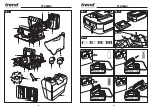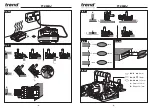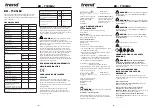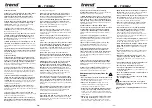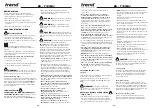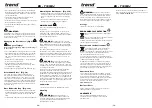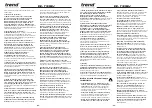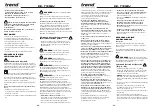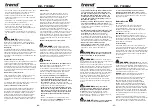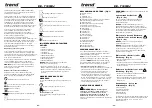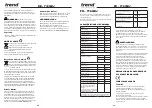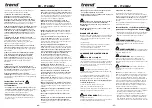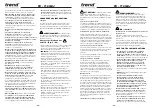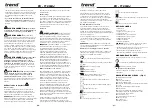
EN - T18S/BJ
EN - T18S/BJ
-11-
-10-
2) Electrical Safety
a) Power tool plugs must match the outlet. Never
modify the plug in any way. Do not use any
adapter plugs with earthed (grounded) power
tools.
Unmodified plugs and matching outlets will
reduce risk of electric shock.
b) Avoid body contact with earthed or grounded
surfaces such as pipes, radiators, ranges and
refrigerators.
There is an increased risk of electric
shock if your body is earthed or grounded.
c) Do not expose power tools to rain or wet
conditions.
Water entering a power tool will increase
the risk of electric shock.
d) Do not abuse the cord. Never use the cord for
carrying, pulling or unplugging the power tool.
Keep cord away from heat, oil, sharp edges or
moving parts.
Damaged or entangled cords increase
the risk of electric shock.
e) When operating a power tool outdoors, use an
extension cord suitable for outdoor use.
Use of a
cord suitable for outdoor use reduces the risk of electric
shock.
f) If operating a power tool in a damp location is
unavoidable, use a residual current device (RCD)
protected supply.
Use of an RCD reduces the risk of
electric shock.
3) Personal Safety
a) Stay alert, watch what you are doing and use
common sense when operating a power tool. Do
not use a power tool while you are tired or under
the influence of drugs, alcohol or medication.
A
moment of inattention while operating power tools may
result in serious personal injury.
b) Use personal protective equipment. Always
wear eye protection
. Protective equipment such as
dust mask, non-skid safety shoes, hard hat or hearing
protection used for appropriate conditions will reduce
personal injuries.
c) Prevent unintentional starting. Ensure the
switch is in the off-position before connecting to
power source and/or battery pack, picking up or
carrying the tool.
Carrying power tools with your finger
on the switch or energising power tools that have the
switch on invites accidents.
d) Remove any adjusting key or wrench before
turning the power tool on.
A wrench or a key left
attached to a rotating part of the power tool may result in
personal injury.
e) Do not overreach. Keep proper footing and
balance at all times.
This enables better control of the
power tool in unexpected situations.
f) Dress properly. Do not wear loose clothing or
jewellery. Keep your hair and clothing away from
moving parts.
Loose clothes, jewellery or long hair can
be caught in moving parts.
g) If devices are provided for the connection of
dust extraction and collection facilities, ensure
these are connected and properly used.
Use of dust
collection can reduce dust-related hazards.
h) Do not let familiarity gained from frequent use
of tools allow you to become complacent and
ignore tool safety principles.
A careless action can
cause severe injury within a fraction of a second.
4) Power Tool Use and Care
a) Do not force the power tool. Use the correct
power tool for your application.
The correct power
tool will do the job better and safer at the rate for which
it was designed.
b) Do not use the power tool if the switch does
not turn it on and off.
Any power tool that cannot be
controlled with the switch is dangerous and must be
repaired.
c) Disconnect the plug from the powersource and/
or the battery pack, if detachable, from the power
tool before making any adjustments, changing
accessories, or storing power tools.
Such preventive
safety measures reduce the risk of starting the power
tool accidentally.
d) Store idle power tools out of the reach of
children and do not allow persons unfamiliar with
the power tool or these instructions to operate the
power tool.
Power tools are dangerous in the hands of
untrained users.
e) Maintain power tools and accessories. Check
for misalignment or binding of moving parts,
breakage of parts and any other condition that
may affect the power tool’s operation. If damaged,
have the power tool repaired before use.
Many
accidents are caused by poorly maintained power tools.
f) Keep cutting tools sharp and clean.
Properly
maintained cutting tools with sharp cutting edges are
less likely to bind and are easier to control.
g) Use the power tool, accessories and tool bits,
etc. in accordance with these instructions, taking
into account the working conditions and the work
to be performed.
Use of the power tool for operations
different from those intended could result in a hazardous
situation.
h) Keep handles and grasping surfaces dry, clean
and free from oil and grease.
Slippery handles and
grasping surfaces do not allow for safe handling and
control of the tool in unexpected situations.
5) Battery Tool Use and Care
a) Recharge only with the charger specified by the
manufacturer.
A charger that is suitable for one type
of battery pack may create a risk of fire when used with
another battery pack.
b) Use power tools only with specifically
designated battery packs.
Use of any other battery
packs may create a risk of injury and fire.
c) When battery pack is not in use, keep it away
from other metal objects, like paper clips, coins,
keys, nails, screws or other small metal objects,
that can make a connection from one terminal to
another.
Shorting the battery terminals together may
cause burns or a fire.
d) Under abusive conditions, liquid maybe
ejected from the battery; avoid contact. If contact
accidentally occurs, flush with water. If liquid
contacts eyes, additionally seek medical help.
Liquid ejected from the battery may cause irritation or
burns.
e) Do not use a battery pack or tool that is
damaged or modified.
Damaged or modified batteries
may exhibit unpredictable behaviour resulting in fire,
explosion or risk of injury.
f) Do not expose a battery pack or tool to fire
or excessive temperature.
Exposure to fire or
temperature above 130°C may cause explosion.
g) Follow all charging instructions and do not
charge the battery pack or tool outside the
temperature range specified in the instructions.
Charging improperly or at temperatures outside the
specified range may damage the battery and increase
the risk of fire.
6) Service
a) Have your power tool serviced by a qualified
repair person using only identical replacement
parts.
This will ensure that the safety of the power tool
is maintained.
b) Never service damaged battery packs.
Service
of battery packs should only be performed by the
manufacturer or authorized service providers.
Additional Safety Instructions for
Jointers
•
Disc cutters must be rated for at least the speed
marked on the tool.
Disc cutters running over rated
speed can fly apart and cause injury.
•
Always use the guard.
The guard protects the
operator from broken disc cutter fragments and
unintentional contact with the disc cutter.
•
Hold power tool by insulated gripping surfaces,
because the cutter may contact its own cord.
Cutting a “live” wire may make exposed metal parts
of the power tool “live” and could give the operator an
electric shock.
•
Always use correctly sized cuttings discs with
the fit- ting mounting bore.
Cutting discs that do
not fit to the mounting components of the biscuit
jointer rotate irregu- larly and lead to loss of control.
•
Apply the machine to the workpiece only when
switched on.
Otherwise there is danger of kickback
when the cutting tool jams in the workpiece.
•
Keep your hands away from the cutting area and
the cutting disc.
Hold the auxiliary handle with your
second hand. When both hands hold the machine,
they cannot be injured by the cutting disc.
•
Never cut over metal objects, nails or screws.
The rout- er bit can become damaged and lead to
increased vibra- tions.
•
Use suitable detectors to determine if utility
lines are hidden in the work area or call the
local utility company for assistance.
Contact
with electric lines can lead to fire and electric
shock. Damaging a gas line can lead to explo- sion.
Penetrating a water line causes property damage or
may cause an electric shock.
•
Do not use blunt or damaged Disc Cutters.
Blunt
or damaged Disc Cutters cause increased friction, can
become jammed and lead to imbalance.
•
When working with the machine, always hold it
firmly with both hands and provide for a secure
stance.
The power tool is guided more secure with
both hands.
•
Secure the workpiece.
A workpiece clamped with
clamp- ing devices or in a vice is held more secure
than by hand.
•
Always wait until the machine has come to a
complete stop before placing it down.
The tool
insert can jam and lead to loss of control over the
power tool.
•
Use auxiliary handle(s), if supplied with the tool.
Loss of control can cause personal injury.
•
The slip safety must always be mounted.
•
Use only the application tools listed in these
operating instructions.
Do not use cutting discs or
circular saw blades.
•
Press the spindle lock button only when the ma-
chine is at a standstill.
•
Before putting into operation, check the cutting
disc for tight seating.
Check the proper function of the guard
retracting system before use. Do not to use blunt
or damaged disc cutters.
Only disk cutter complying with EN 847-1 can be
used.


